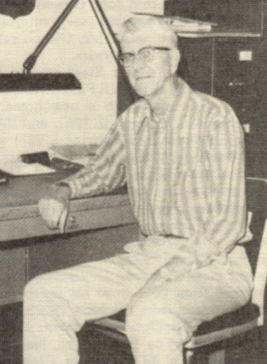SOIL CONSERVATION IN HOOKER COUNTY
by Vera Sautter
Entry T4 from the History of Hooker County Nebraska
with permission of the Hooker County Historical Society

Selvester Vanderbeek - Early 1970's. First Soil
Conservationist in Hooker County.
Hooker County is near the center of the
Sandhills Region in Nebraska. It is an area
of Sandy Soils almost entirely covered by
native grasses. Raising of beef cattle is the
main enterprise. Only small areas are culti-
vated, and these mainly to grow winter feed
for cattle that graze the rangeland. The total
area of the county is approximately 461,000
acres, and less than 3,000 acres of this is
cultivated.
In 1874, or thereabouts, cattlemen who had
ranches in the Platte Valley to the south
began to use the area now within Hooker
County as summer range. About ten years
later, homesteaders began to arrive. In spite
of opposition from the cattlemen, who were
grazing Government land, the number of
homesteaders increased.
Hooker County was among the last settled
in Nebraska, and for this reason, some of the
mistakes made by earlier settlers were avoi-
ded. Nevertheless, many of the homesteaders
were from the east. They had few cattle and
they plowed the sandy soils to grow corn and
other grains for their hogs and chickens.
Eventually, a maximum of about 25,000 acres
was brought under cultivation. The yields
obtained shortly after breaking the sandy
soils soon declined, and this, combined with
wind erosion and the severe drought of the
1930's, brought about conversion of most of
the cultivated land back to grass, by soil
survey of Hooker County, Nebraska in 1964.
The main resources of the county, grass
and water, are now utilized effectively in
producing beef. This return to grass from
cultivation was achieved with the technical
help of soil conservationists, supplied by the
Soil Conservation Service, established by the
Federal Government after the drought of the
1930's.
Sylvester Vanderbeek was the first Soil
Conservationist assigned to Hooker County.
In 1950 the Grant-Hooker Soil and Water
Conservation District was formed with tech-
nical assistance by "Van". Some of the first
Directors of the SWCD, included W.R.
Machlan ( 1950- 1961 ) , Marvin Tucker, E.H.
Howarth, Curt Merrihew, Bernard Adam,
Sid Manning, Wallace Adam. In the begin-
ning, the major problems to contend with
included; seed old fields, seed old cropland to
cool season grasses for early fall and spring
pastures, re-vegetation of blow-outs, irriga-
tion of pasture and hayland, proper stocking,
better utilization of rangeland and tree
planting. "Van" served as conservationist for
22 years. He passed away in 1972. John
Sautter served as conservationist from 1972-
1983. Rollin Clouse served, 1983-1986. The
present conservationist is Barbara Rush. The
Grant-Hooker soil and Water Conservation
District was merged with Logan, Thomas,
Blaine, Brown, east half of McPherson and
south Cherry counties, in 1973, to form the
Upper Loup Natural Resource District.
Directors associated with this District in-
clude Wilbert Ericksen, Forrest Harding,
Kenneth Boyer, Tilbert Wright, Lyle Phil-
lips, John Sautter and Vera Sautter. E.A.
Howarth served as Supervisor 1951-'71, and
Wilbert Erickson, 1960- 1978.
The main resources of the county, grass
and water, are now utilized effectively in
producing beef. Good distribution of water
allows efficient use of rangeland. Under-
ground water of good quality is plentiful, and
the Middle Loup and Dismal Rivers flow in
the County. Ranches in Hooker County are
large, and for the most part are owned by the
operators. Hooker County has been blessed
with caring people.
